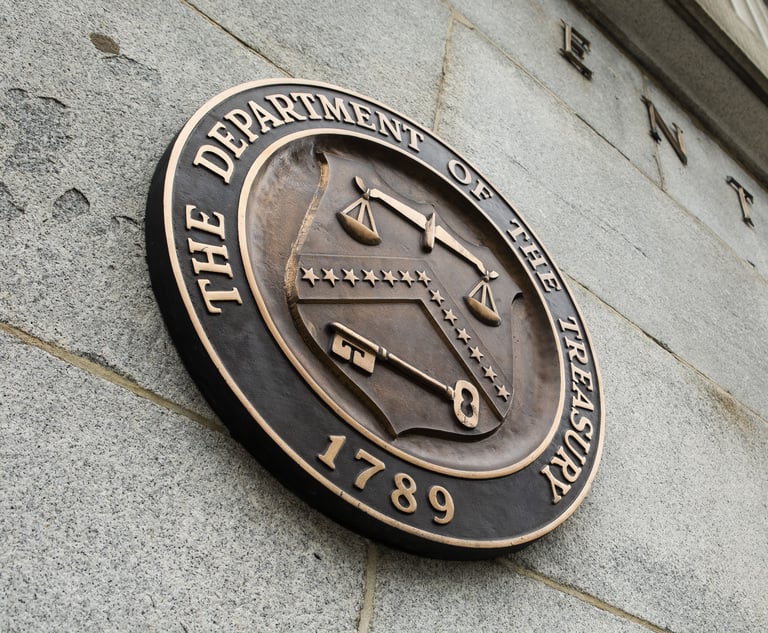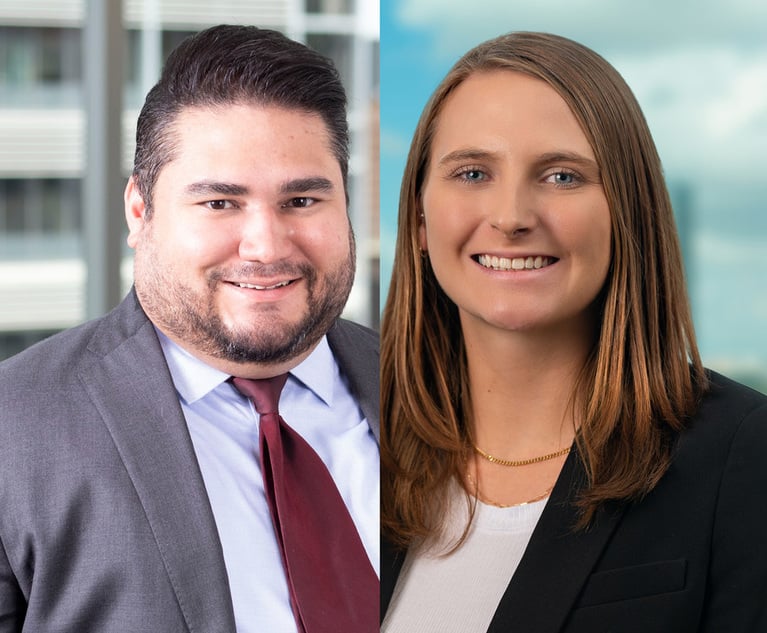 John Kalas ,left, and Michael Moran ,right, of Nelson Mullins. Courtesy photos
John Kalas ,left, and Michael Moran ,right, of Nelson Mullins. Courtesy photos Federal Rule of Evidence 806—A Useful Tool to Demonstrate Bias in Serial Tort Litigation
Practitioners should keep Rule 806 in mind when engaged in serial litigation. Though the case law in civil matters is scarce, the plain language of the rule and its application and purpose should provide avenues for its use when faced with slanted learned treatises offered into evidence from unavailable witnesses.
June 13, 2024 at 12:56 PM
7 minute read
Board of ContributorsThe use of videotaped deposition testimony at trial has been commonplace now for decades and is the bread and butter of many serial tort cases. Upon a showing of witness unavailability, the federal rules allow for the presentation of video testimony, see e.g., Federal Rules of Civil Procedure (FRCP) 32(a) and Federal Rules of Evidence (FRE) 804, in some cases even when the deposition testimony was taken in a different matter involving different parties. See FRE 804(b)(1). However, in serial tort litigation courts have sometimes treated this as a one-way street, allowing plaintiffs to use depositions taken in other cases against defendants but not letting the defendant use the same sorts of depositions offensively if the same plaintiff was not present at the deposition. The reasoning lies in the language of 804(b)(1) which requires analyzing whether the party against whom it's offered "had—or, in a civil case, whose predecessor in interest had—an opportunity and similar motive to develop it by direct, cross-, or redirect examination." See FRE 804(b)(1)(B). A court's inquiry is relatively straightforward when it comes to using the testimony against a corporate defendant in serial litigation—they were present at the first deposition, and if it is on roughly the same subject matter, they would have had an opportunity and similar motive to develop the testimony during the proceeding.
On the other hand, the court's inquiry under 804(b)(1) is more complicated and context specific when a corporate defendant attempts to use a deposition of an unavailable witness offensively in litigation. The key difference is that when a defendant attempts to use the deposition, the plaintiff present at the deposition will almost always differ from the plaintiff against whom the testimony is being offered at trial. Though many courts have allowed such use under Rule 804(b)(1) or its state-rule equivalent after finding the previous plaintiff was a "predecessor in interest," see, e.g., Horne v. Owens-Corning Fiberglas, 4 F.3d 276 (4th Cir. 1993); Rich v. Kaiser-Gypsum, 103 So.3d 903 (Fla. Ct. App. 4th 2012), other courts have found that a former plaintiff is not a predecessor in interest of a current plaintiff in serial litigation. See Freeman v. Ethicon, 2022 WL 17348191 (C.D. Ca. Sept. 13, 2022) (finding that the prior plaintiffs did not share a similar motive in which they had a "similar motive" to present plaintiffs; therefore, precluding the use of the prior deposition testimony proposed by defendants).
This content has been archived. It is available through our partners, LexisNexis® and Bloomberg Law.
To view this content, please continue to their sites.
Not a Lexis Subscriber?
Subscribe Now
Not a Bloomberg Law Subscriber?
Subscribe Now
NOT FOR REPRINT
© 2025 ALM Global, LLC, All Rights Reserved. Request academic re-use from www.copyright.com. All other uses, submit a request to [email protected]. For more information visit Asset & Logo Licensing.
You Might Like
View All

Don’t Forget the Owner’s Manual: A Guide to Proving Liability Through Manufacturers’ Warnings and Instructions
5 minute read

Law Firms Mentioned
Trending Stories
- 15th Circuit Considers Challenge to Louisiana's Ten Commandments Law
- 2Crocs Accused of Padding Revenue With Channel-Stuffing HEYDUDE Shoes
- 3E-discovery Practitioners Are Racing to Adapt to Social Media’s Evolving Landscape
- 4The Law Firm Disrupted: For Office Policies, Big Law Has Its Ear to the Market, Not to Trump
- 5FTC Finalizes Child Online Privacy Rule Updates, But Ferguson Eyes Further Changes
Who Got The Work
J. Brugh Lower of Gibbons has entered an appearance for industrial equipment supplier Devco Corporation in a pending trademark infringement lawsuit. The suit, accusing the defendant of selling knock-off Graco products, was filed Dec. 18 in New Jersey District Court by Rivkin Radler on behalf of Graco Inc. and Graco Minnesota. The case, assigned to U.S. District Judge Zahid N. Quraishi, is 3:24-cv-11294, Graco Inc. et al v. Devco Corporation.
Who Got The Work
Rebecca Maller-Stein and Kent A. Yalowitz of Arnold & Porter Kaye Scholer have entered their appearances for Hanaco Venture Capital and its executives, Lior Prosor and David Frankel, in a pending securities lawsuit. The action, filed on Dec. 24 in New York Southern District Court by Zell, Aron & Co. on behalf of Goldeneye Advisors, accuses the defendants of negligently and fraudulently managing the plaintiff's $1 million investment. The case, assigned to U.S. District Judge Vernon S. Broderick, is 1:24-cv-09918, Goldeneye Advisors, LLC v. Hanaco Venture Capital, Ltd. et al.
Who Got The Work
Attorneys from A&O Shearman has stepped in as defense counsel for Toronto-Dominion Bank and other defendants in a pending securities class action. The suit, filed Dec. 11 in New York Southern District Court by Bleichmar Fonti & Auld, accuses the defendants of concealing the bank's 'pervasive' deficiencies in regards to its compliance with the Bank Secrecy Act and the quality of its anti-money laundering controls. The case, assigned to U.S. District Judge Arun Subramanian, is 1:24-cv-09445, Gonzalez v. The Toronto-Dominion Bank et al.
Who Got The Work
Crown Castle International, a Pennsylvania company providing shared communications infrastructure, has turned to Luke D. Wolf of Gordon Rees Scully Mansukhani to fend off a pending breach-of-contract lawsuit. The court action, filed Nov. 25 in Michigan Eastern District Court by Hooper Hathaway PC on behalf of The Town Residences LLC, accuses Crown Castle of failing to transfer approximately $30,000 in utility payments from T-Mobile in breach of a roof-top lease and assignment agreement. The case, assigned to U.S. District Judge Susan K. Declercq, is 2:24-cv-13131, The Town Residences LLC v. T-Mobile US, Inc. et al.
Who Got The Work
Wilfred P. Coronato and Daniel M. Schwartz of McCarter & English have stepped in as defense counsel to Electrolux Home Products Inc. in a pending product liability lawsuit. The court action, filed Nov. 26 in New York Eastern District Court by Poulos Lopiccolo PC and Nagel Rice LLP on behalf of David Stern, alleges that the defendant's refrigerators’ drawers and shelving repeatedly break and fall apart within months after purchase. The case, assigned to U.S. District Judge Joan M. Azrack, is 2:24-cv-08204, Stern v. Electrolux Home Products, Inc.
Featured Firms
Law Offices of Gary Martin Hays & Associates, P.C.
(470) 294-1674
Law Offices of Mark E. Salomone
(857) 444-6468
Smith & Hassler
(713) 739-1250






